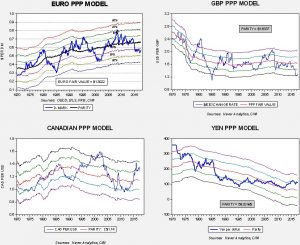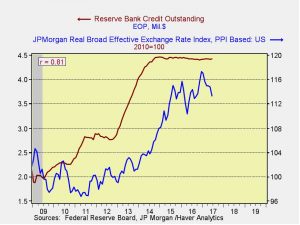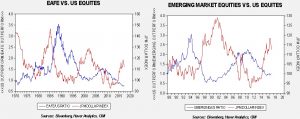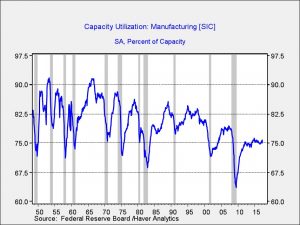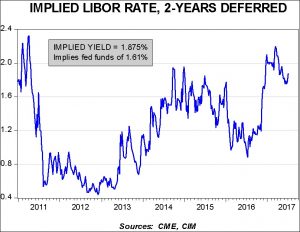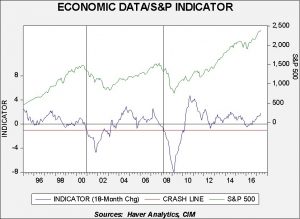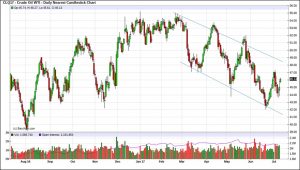by Bill O’Grady and Thomas Wash
[Posted: 9:30 AM EDT] It’s another quiet, summertime session. Here are the items we are watching this morning:
OPEC meeting: The OPEC meeting is wrapping up with no new production cuts. However, Saudi Arabia has promised to reduce its oil exports which is modestly positive. As we noted last week, Saudi oil exports tend to fall in the northern hemisphere summer due to rising electricity demand in the kingdom. Thus, the decision to “reduce” exports has more to do with the need for domestic energy. It is a bullish move in the short run but we doubt exports will remain at summer levels once autumn comes. In addition, Kuwait noted that the cartel may extend production cuts past Q1 2018, taking a page out of the central bank’s playbook of managing expectations. Over the past decade, central banks have used the concept of “forward guidance” to steer policy expectations. Kuwait’s comment hints that the cartel may be planning something similar. Overall, the meeting was neutral to negative for oil prices; the market was hopeful that OPEC would announce further production cuts, but didn’t expect them. If Saudi oil export cuts allow for a drop in U.S. oil inventories, it would be bullish for oil prices.
Venezuelan sanction threats get serious: The Trump administration is considering financial sanctions on Venezuela that would prohibit the Venezuelan state oil company, PDVSA, from making dollar transactions. This would mean the country would be isolated from the U.S. financial system and the global reserve currency. Since oil is priced in dollars, this would be a major blow to the country. Although PDVSA could accept another currency, say, the EUR, the European banks would not want to risk U.S. sanctions and probably would not participate in PDVSA transactions. This would leave Venezuela to the “tender mercies” of Russia and China, both major creditors of the Maduro government. The U.S. has threatened the sanctions if the Maduro government goes ahead with making a new constitution.
The importance of “Mooch”: Last week, President Trump shook up his White House by appointing Anthony Scaramucci as communications director. Known as “Mooch,” his appointment was vehemently opposed by Chief of Staff Priebus and Advisor Bannon. On the face of it, this appointment shouldn’t affect markets directly so, normally, we wouldn’t comment. However, this one may change the shape of things and thus requires some examination. It appears that Priebus’s objection is mostly personal; he doesn’t seem to like Scaramucci and the appointment undermines Priebus’s authority since Scaramucci will directly report to the president. The resignation of Priebus’s ally, Sean Spicer, further undermines the Chief of Staff. Bannon’s distrust of Scaramucci is more due to his Wall Street ties. Bannon fears that Trump has another establishment figure who will fall in line with Mnuchin and Cohn. Here are some reasons we are watching this appointment with interest. First, if Priebus resigns, and odds are high that he will, Cohn is the most likely replacement. This might mean he won’t become Fed Chair and would reopen this position. Kevin Warsh would be the likely leading candidate for Fed Chair (Warsh is probably a hawk). Second, if Bannon decides he is isolated and the establishment has won, he too may resign and the populist cause is probably lost. Thus, the Mooch appointment could be a big deal.
The sanctions bill: A bill putting new sanctions on Russia, Iran and North Korea is headed for the president’s desk. Although there is much controversy surrounding Russia, most presidents don’t like foreign policy from Congress. As with every bill, the president will have two choices; he can sign the bill and limit his ability to operate in foreign policy. Or, he can veto the bill and raise concerns that he is unwilling to punish Russia and cause more headaches for the White House. We suspect he will reluctantly sign the bill, especially because it also includes actions against Iran and North Korea. At the same time, we want to reiterate that no administration wants foreign policy meddling from Congress.
Infrastructure looks dead: The NYT reported over the weekend that a move to boost infrastructure spending has mostly fallen by the wayside. The establishment GOP was never much in favor of spending on fears it mostly bolsters Democrat Party supporters; in addition, they didn’t want to raise the deficit or increase taxes to fund spending. There has been some interest in public/private partnerships but those are limited to projects that generate a stream of income. In a world with very low interest rates, if such projects were easily feasible, one would think they would have already been funded. Allowing infrastructure spending to stagnate will potentially hurt the president in 2020 as his support of such a program was popular with the right-wing populists.
Capital flight discussed: Emily Badger had a column in yesterday’s NYT discussing the impact of foreign capital flight into local real estate markets. The influx of foreign money has tended to raise prices in these select areas, boosting the wealth of existing homeowners but making it difficult for new buyers to afford housing in these areas. The article mentions that China alone invested $153 bn in U.S. real estate last year (03/16 – 03/17), up 49% from the previous year. We suspect the money coming in is price insensitive as it represents an “escape pod” for wealthy foreigners looking to secure a space in the U.S. in case of future unrest at home. For the U.S., these inflows are a mixed bag. The investment should be welcome but the concentration of buying does affect American buyers and can force U.S. citizens to live in regions that are not their first choice.
Manafort, Kushner, Trump (Donald, Jr.) testify today: The session before the Senate Intelligence Committee is closed and not under oath. We don’t expect anything initially out of the testimony, although we do look for leaks to emerge in the coming days. If there is anything to this Russian situation, this meeting will be the preliminary one.



